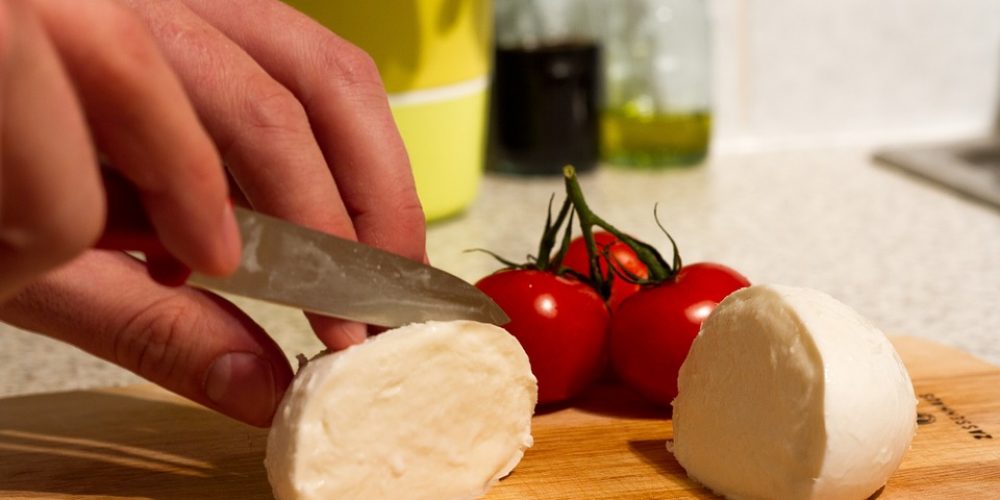Fresh Mozzarella: (fast method, made with citric acid or vinegar)
As an introduction you can read my article about Mozzarella Cheese, and I would recommend reading the my article How to Make Cheese at Home.
For supplies needed and where to find them, you can visit my Cheese Making Kit review page where I share my opinions and experience using different products and tools.
Mozza is one of the most consumed cheeses worldwide, especially because of its commercial use on Pizza. This Mozza recipe will make a Mozza that can be consumed right away.
The Mozzarella curd needs to be stretched or pulled. In order for the stretching to work, the acidity of the milk needs to be lowered to an exact pH level. Since most home cheese makers don’t have a pH meter, it is very important that you follow the EXACT instructions. Homogenized milk doesn’t stretch as well as non-homo milk. Homo milk still makes a good Mozza, but if you have access to a non – homo milk that would be preferable.
I will give you two options to adjust the acidity. One is with citric acid and the other is with white or apple cider vinegar. Use the exact amounts of milk and acid from this recipe. It is based on 2L/ 2qrt of fresh milk. If you use 4L/ 1gal, you can multiply the amount of citric acid or vinegar by 2.
It is important that you use an accurate thermometer. When we stretch the curd it needs to go into hot water first and the temperature of the hot water needs to be exact.
Mozza is a lot of fun to make, especially once you figured out the stretching. The challenge is that the pH or acidity level of the milk, and later the curd, has to be accurate for the stretching to work. Without a pH meter this can involve a bit of a guessing and experimenting. The good news is that even if the stretch doesn’t work 100%, you will still have a decent cheese. Making a good Mozza will take a bit of practice. As always, if you have questions leave them below in the comment box, I am happy to help.
Ingredients
- 2L/ 2qrt Milk, raw or pasteurized, homo or non-homo, whole or partly skimmed
- Half a teaspoon of Citric acid diluted in ⅛ cup of cold water or 40 g/ 1 ¼ fluid oz of white or apple cider vinegar. You can order citric acid here.
- ⅛ of a rennet tablet mixed in ⅛ cup water or 10 drops of liquid rennet mixed in ⅛ cup water. You can order rennet here.
- 1 bowl of salted cold water. Use 2 tbsp per 1L/ 1Qrt of cold water.
Tools needed:
- Pot to comfortably hold the milk
- Sharp knife
- Past strainer
- Cheesecloth
- Kitchen strainer
Procedure
- Heat the milk to 32C/90F stirring well.
- Add the citric acid or the vinegar. Add it slowly and stir intensely.
- If you have a pH meter, set the pH at 5.6.
- Add the rennet, stir for 10 seconds then stop the milk from moving. The milk should coagulate in 10 to 15 minutes, if it takes longer, just wait. If you used liquid rennet, be aware that they come in different strengths and you might need to find out how much to use.
- Once the milk has coagulated, cut it into 1 inch squares with a kitchen knife. Then use a whisk to break the curd apart. Then use a ladle to stir the curd until it starts to clearly separate from the whey.
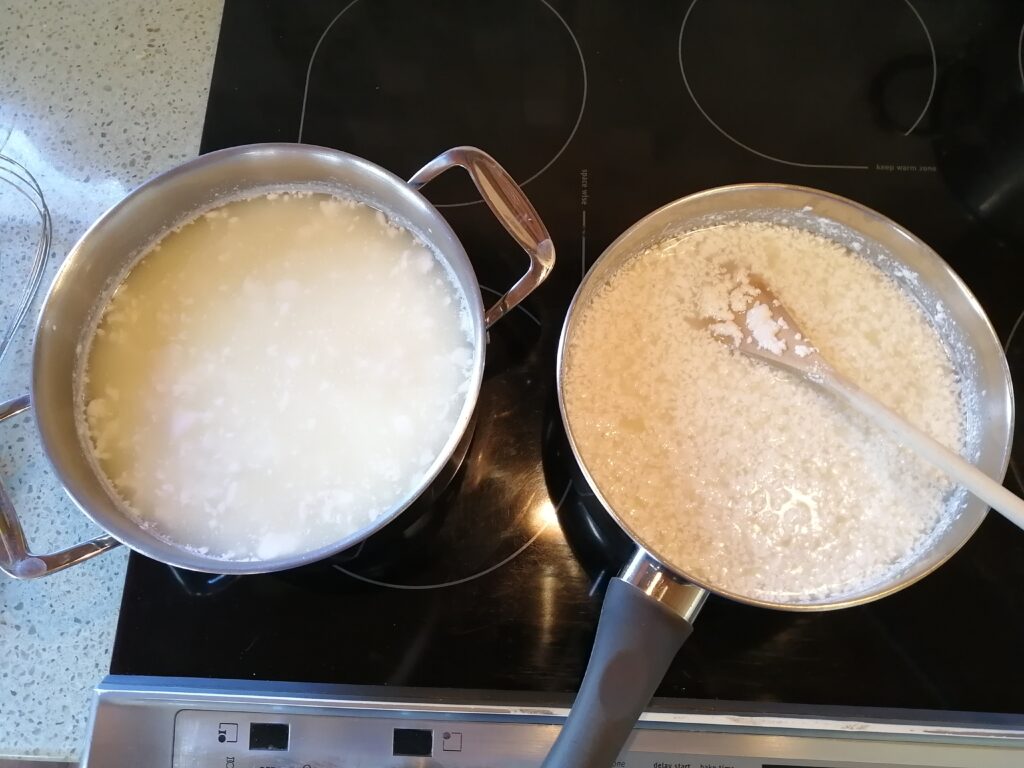
On the right fresh cut curd. On the left, after 10 minutes the curd sets to the bottom of the pan.
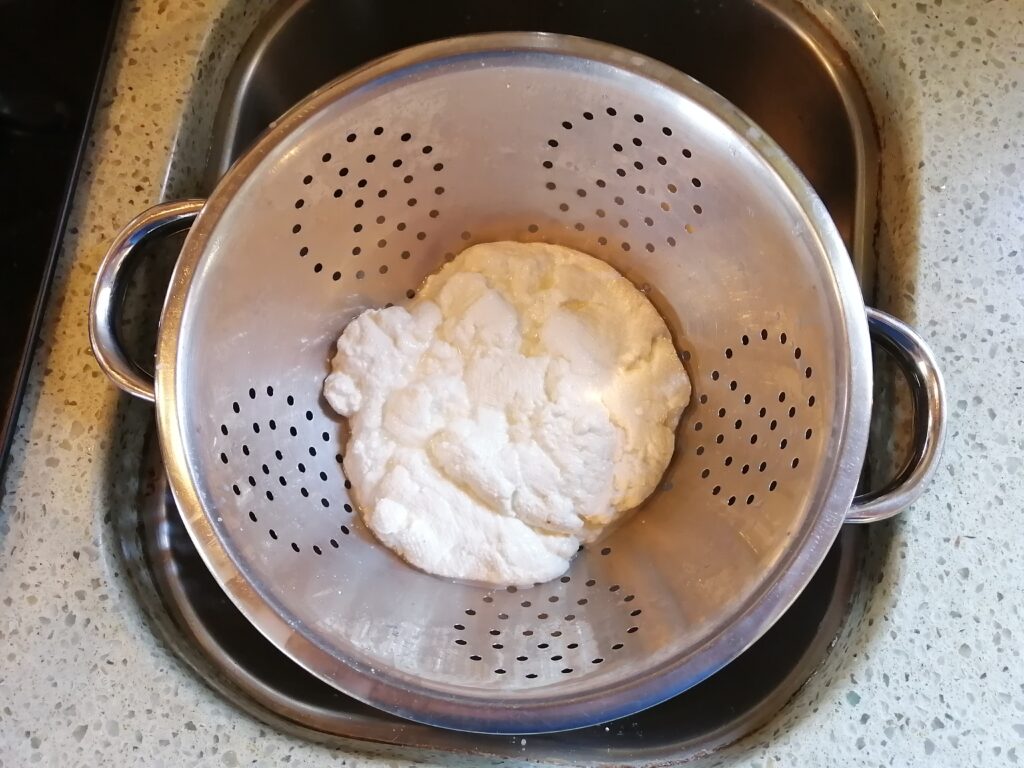
Drained Mozza, ready for stretching
- Slowly heat the curd to 41C/105F, stir well, but gently. Once it has reached the temperature, let the curd sit for 10 minutes.
- Line a pasta strainer with cheesecloth and pour the curd into the cloth. The whey should drain away quite fast. You can squeeze the cheese cloth to speed up the draining. You can save the whey to later make Ricotta.
- Once the curd takes shape you can remove it from the cloth and place it into the pasta strainer.
- Prepare a pan with about 2L/2qurt of water and heat it to 80C/176F. Place a kitchen strainer over the pan, then cut a piece off the curd and place it into the strainer.
- Submerge the curd with the strainer into the hot water, while moving it around. Stick the thermometer into the curd and remove it once it has reached 57C/135F.

Hot water on the right and cold water on the left. Mozza cut in slices ready to be stretched.
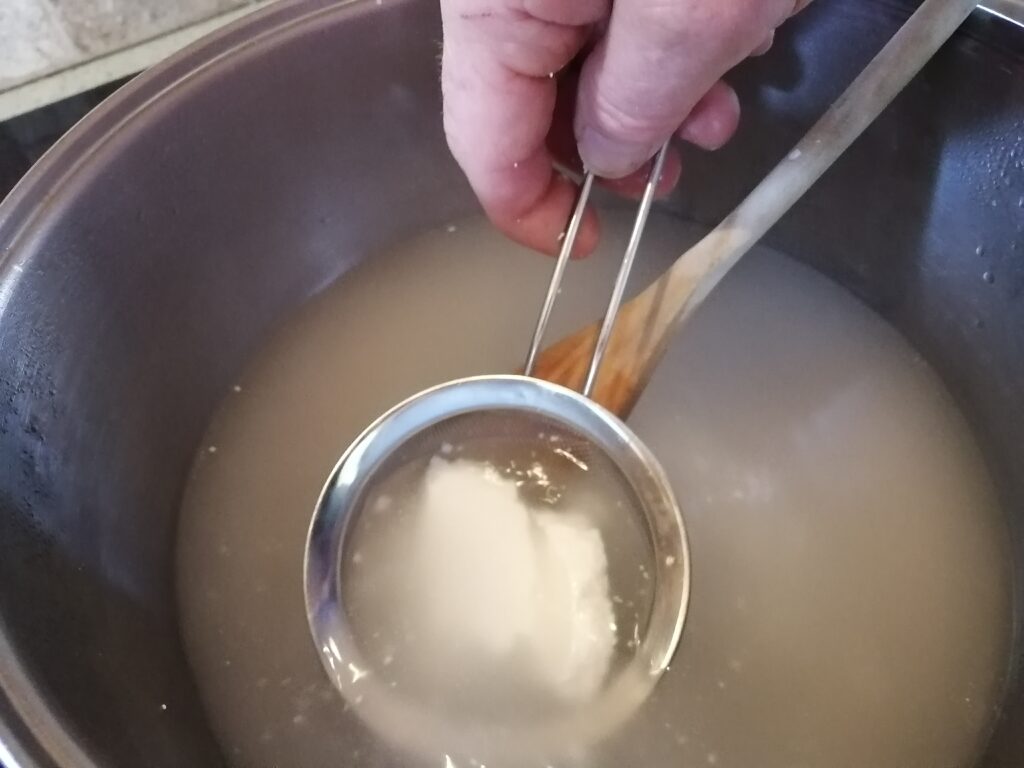
Submerging the cheese into the hot water for about 30 seconds.
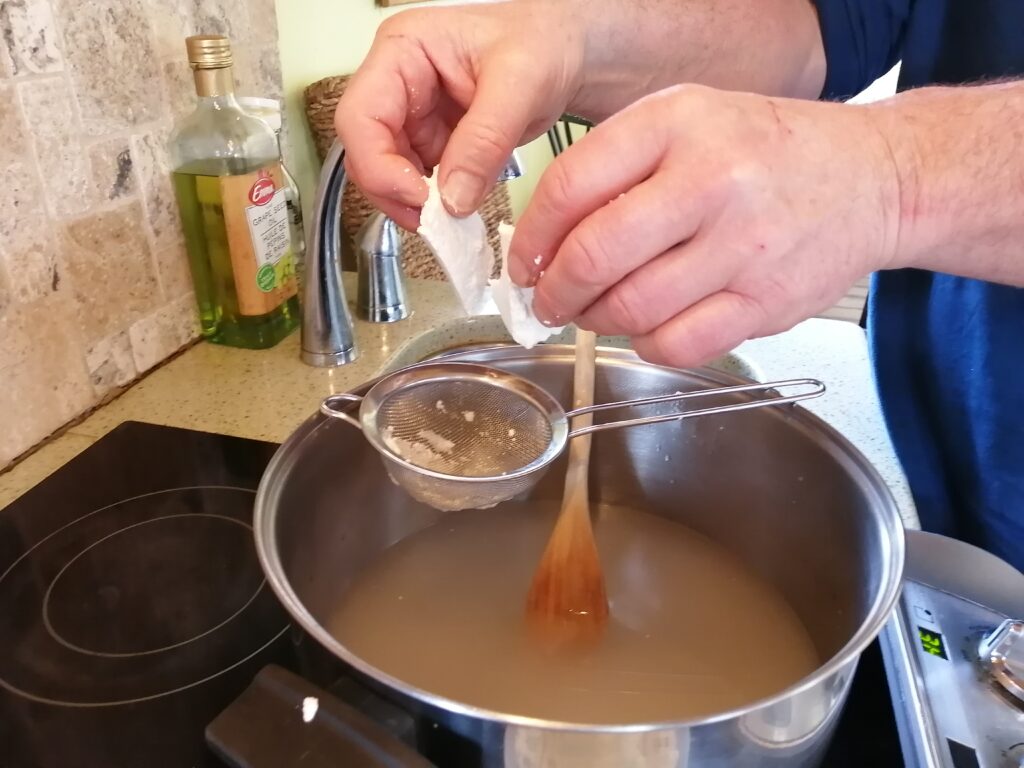
Placing the cheese into the strainer.
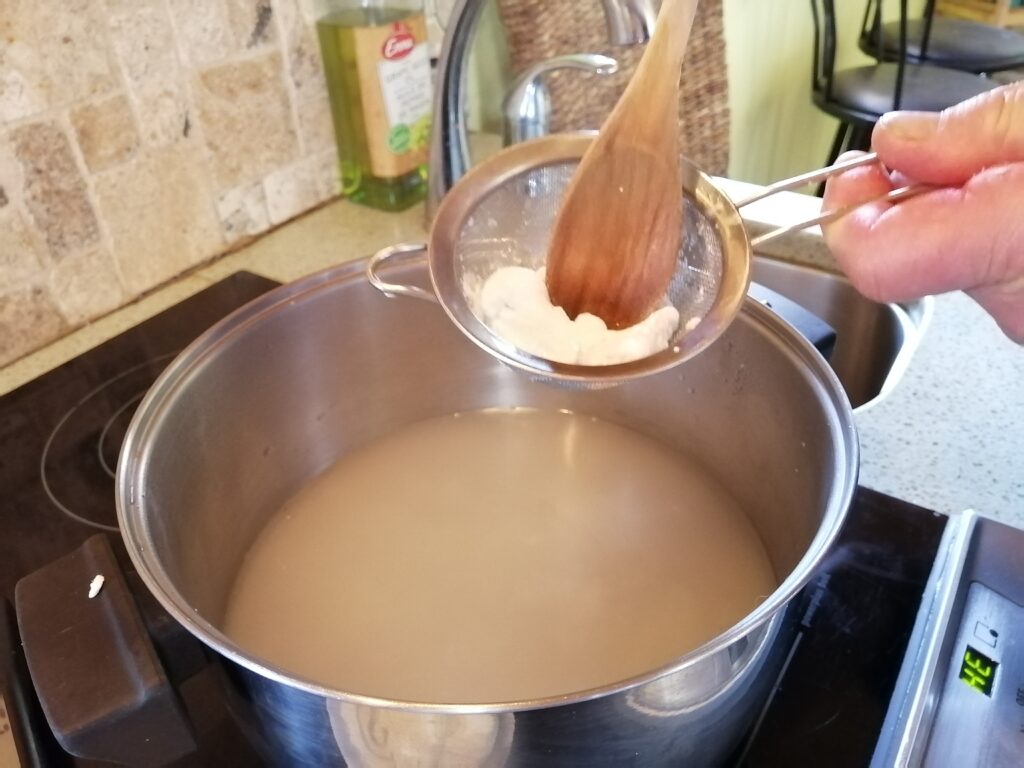
working the hot cheese mass with a ladle.
- Use a ladle to knead the hot curd in the strainer for a few seconds, then put it into your hands and work it until it develops a plasticity. Form a ball and place it into the salted cold water.Repeat until all the curd has been processed. Leave the Mozza balls in the cold brine for 2 hours, then they are ready to eat.
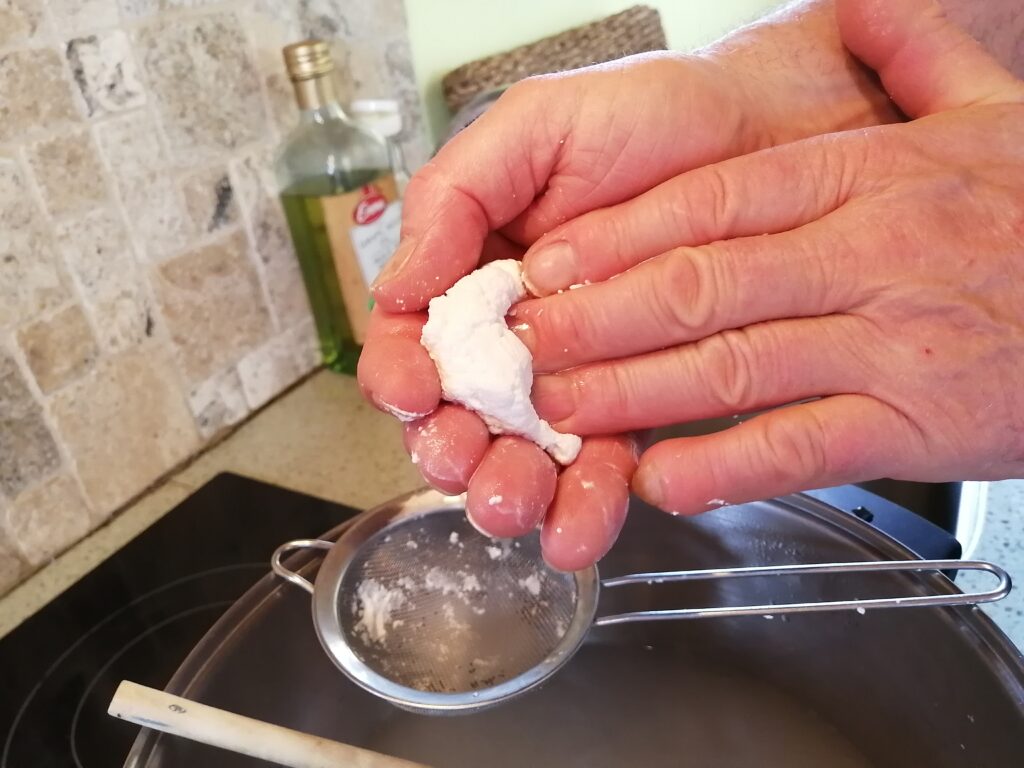
Working the Mozza mass with your hands.
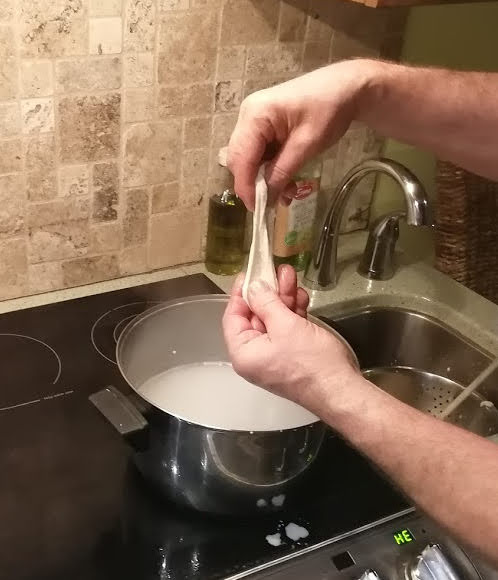
Stretching the hot Mozza

Rolling the Mozza mass into a ball.

Dropping the Mozza balls into salted cold water.

Mozzarella balls after stretching in a light salty brine.
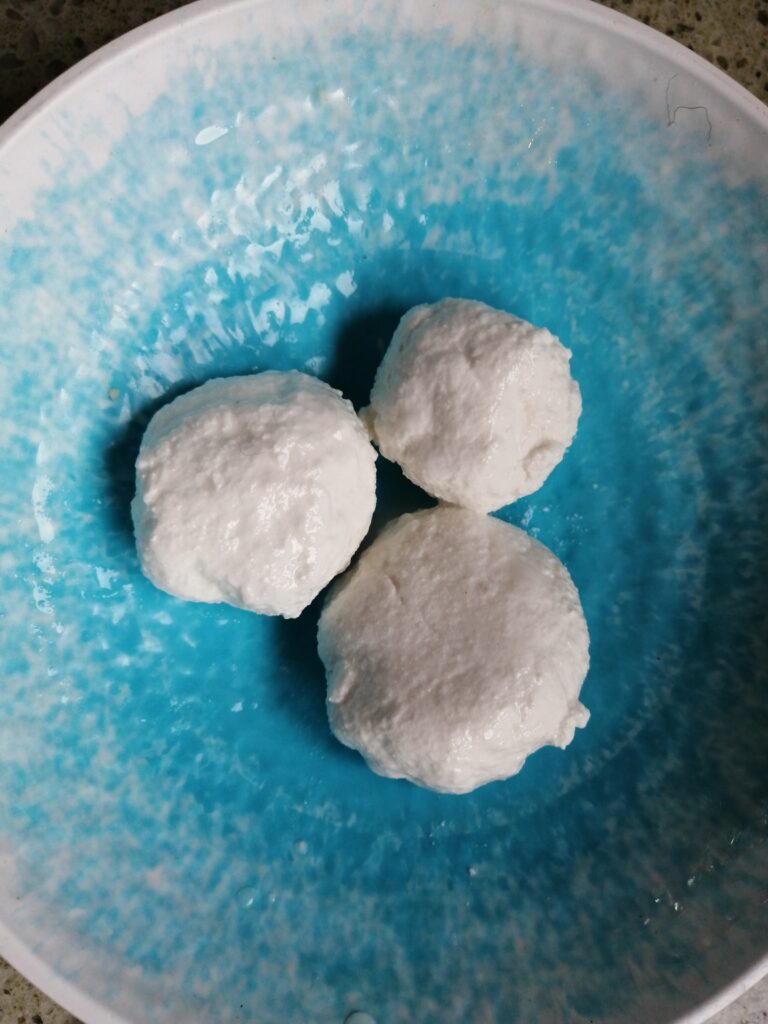
Ready to eat Mozza balls
Troubleshoot
- The milk curdled as soon as you added the acid. This can have two reasons. You either added too much acid by using a big teaspoon, or your milk was not fresh and had a lower acidity to begin with. Use a real teaspoon measuring cup and use fresh milk. If you can’t access fresh milk, then reduce the amount of acid.
- After adding the rennet, the milk did not coagulate.This can happen when your rennet is not active anymore.Your rennet can lose activity if it is too old, or when it is mixed with chlorinated water. This could also happen if your milk was too hot. Make sure your thermometer is accurate.
- After adding the rennet, the milk turned into a flaky mass. This can happen when you use too much acid. You can still make Mozza with this, next time remember to use a bit less acid.
- The curd was really crumbly and was difficult to turn into a ball before stretching. In this case you used too much acid. You can still make a decent cheese with it, but next time cut back a bit on the acid.
- The curd didn’t stretch well and didn’t develop plasticity. There are 3 reasons why this could happen. 1.You either used too much or not enough acid. 2. Your water wasn’t hot enough. 3. you didn’t leave the curd long enough in the hot water. If your curd was slightly dry and hard to form a ball with, you used too much acid. If your curd was very moist and you had a hard time draining it, you didn’t use enough acid. Always make sure your thermometer is accurate. It is a good idea to have 2 thermometers to compare the accuracy of temperature.

